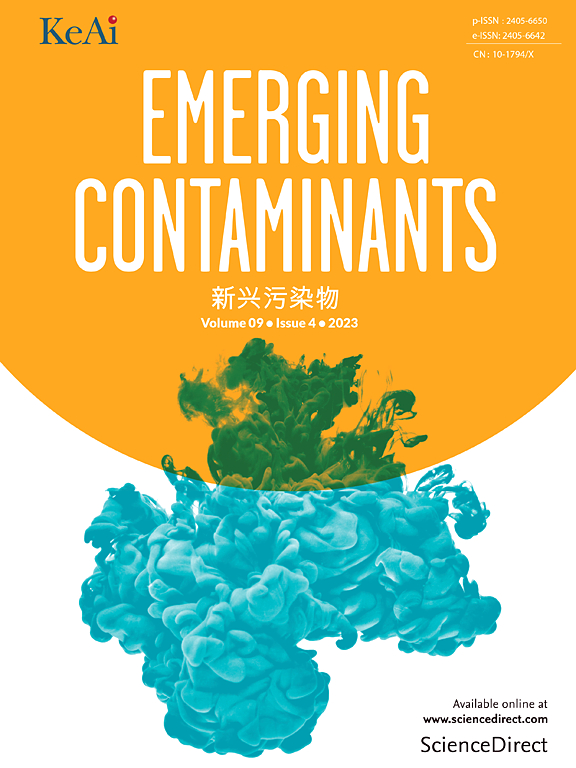通过非靶向和可疑筛选方法阐明胎盘中新兴关注的化学物质
IF 6.9
2区 环境科学与生态学
Q1 ENVIRONMENTAL SCIENCES
引用次数: 0
摘要
在过去的一个世纪里,工业化国家的人类活动已经使人们接触到各种各样的环境化学类物质。其中许多可能对人体健康产生有害影响,胎儿期接触外源性物质尤其令人担忧。越来越多地使用非靶向筛选(NTS)和可疑筛选(SS)方法来研究化学暴露体的大规模开放式特征。本研究的目的是通过使用NTS和SS来识别人类胎盘样本中存在的新出现的关注(CECs)化学物质,从而增加对胎儿暴露于异种抗生素的认识。在比较盐辅助液液萃取+分散液液微萃取(SALLE-DLLME)和增强基质去除(EMR)作为样品制备技术的性能后,我们将EMR应用于来自BAZA西班牙队列的65个胎盘样品。从各种化学类别中鉴定出21种化合物,包括农用化学品、防腐剂、增塑剂、化妆品、织物染料、香料、添加剂、工业中间体和药物,其中一些以前未在胎盘样品中报告过。研究结果证实了非目标方法在全面评估产前人类暴露方面的重要价值,以及它们揭示以前未知或被忽视的暴露的潜力。本文章由计算机程序翻译,如有差异,请以英文原文为准。

Elucidation of chemicals of emerging concern in placenta by non-targeted and suspect screening approaches
Over the past century, anthropic activities in industrialized countries have generated exposure to a vast array of environmental chemical families. Many of these may have harmful effects on human health, and xenobiotic exposure during the fetal period is particularly concerning. Large-scale, open-ended characterization of the chemical exposome is increasingly investigated using non-targeted screening (NTS) and suspect screening (SS) approaches. The aim of this study was to increase knowledge of fetal exposure to xenobiotics by using NTS and SS to identify the presence of chemicals of emerging concern (CECs) in human placenta samples. After comparing the performances of salt-assisted liquid-liquid extraction plus dispersive liquid-liquid microextraction (SALLE-DLLME) and enhanced matrix removal (EMR) as sample preparation techniques, EMR was applied in 65 placenta samples from the BAZA Spanish cohort. Twenty-one compounds from various chemical classes were identified, including agrochemicals, preservatives, plasticizers, cosmetics, fabric dyes, fragrances, additives, industrial intermediates, and drugs, and some of these have not previously been reported in placenta samples. The findings confirm the crucial value of non-targeted methodologies for the comprehensive assessment of human exposure during the prenatal period and their potential to unveil previously unknown or overlooked exposures.
求助全文
通过发布文献求助,成功后即可免费获取论文全文。
去求助
来源期刊

Emerging Contaminants
Medicine-Public Health, Environmental and Occupational Health
CiteScore
10.00
自引率
6.70%
发文量
35
审稿时长
44 days
期刊介绍:
Emerging Contaminants is an outlet for world-leading research addressing problems associated with environmental contamination caused by emerging contaminants and their solutions. Emerging contaminants are defined as chemicals that are not currently (or have been only recently) regulated and about which there exist concerns regarding their impact on human or ecological health. Examples of emerging contaminants include disinfection by-products, pharmaceutical and personal care products, persistent organic chemicals, and mercury etc. as well as their degradation products. We encourage papers addressing science that facilitates greater understanding of the nature, extent, and impacts of the presence of emerging contaminants in the environment; technology that exploits original principles to reduce and control their environmental presence; as well as the development, implementation and efficacy of national and international policies to protect human health and the environment from emerging contaminants.
 求助内容:
求助内容: 应助结果提醒方式:
应助结果提醒方式:


